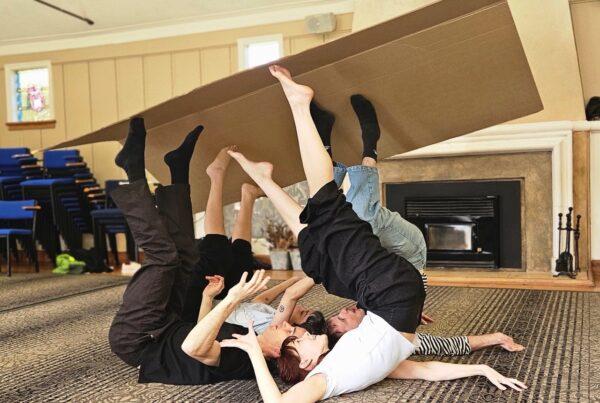Prime Minister asks New Zealanders to… “Be kind. Be strong. Stay home. Save lives.”
New Zealand’s borders are closed and our government says we must all stay at home. All theatres are closed, all productions, rehearsals and workshops cancelled or postponed. But we are resilient. Performing arts companies and practitioners are connecting with their colleagues, audiences and students via the internet and social media, running workshops or working collaboratively via Zoom, issuing creative challenges or sharing recordings of past work via Facebook and YouTube. Others are sorting out funding issues or catching up on admin. ASSITEJ NZ is planning to bring NZ practitioners together next year. Now, while we’re in lockdown, doing our best to be kind and strong, we have time for strategic thinking and a future focus.
Towards the end of last year, PAYPA / ASSITEJ New Zealand and Capital E National Theatre for Children agreed to work more closely together to strengthen New Zealand’s network of children’s theatre practitioners. Capital E National Theatre for Children has been designated by Creative New Zealand as a Tōtara (leadership) organisation for developing and touring theatre for young audiences. Over the next few months, the PAYPA board will work with Capital E to initiate opportunities to bring practitioners together (online or in-person) for forums and discussions with a strong aspirational and future focus. We are also currently working to formalise our PAYPA network, and we are planning to bring practitioners together for a major PAYPA gathering early-mid next year.
When the call for the April newsletter came, we forwarded the key questions in the call to Capital E and received a response that gives a more detailed picture of how New Zealand’s performing arts community is responding to the Covid-19 crisis:
How are artists, audiences, children and young people, governments responding to the crisis in your country?
Aotearoa New Zealand began a Level 4 alert on Thursday 26 March, closing all non-essential businesses, schools and universities, and enforcing lockdown in household ‘bubbles’. In the days leading up to this, schools were prevented from going on trips or allowing visitors onsite, and gatherings were restricted meaning events and performances were cancelled signalling the start of an unprecedented time for our small, tight-knit performing arts ecosystem.
The government was quick to respond with financial support for employers, sole traders, contractors and the self-employed; however, some arts practitioners are reporting variable, even stressful experiences as they try to access this. At the same time, Creative New Zealand announced a COVID-19 Emergency Response Package with a first phase of $16 million of support to help the arts community remain viable. This comes online in mid-April. A phase two will look beyond June 2020 and is yet to be announced.
The reality for many organisations is that we are still moving through our crisis management phase. Signs of consolidation, leadership and innovation are emerging, but it is early days. In New Zealand’s small and often fragile arts community, we are so interconnected and inter-dependent, that collaboration and collegiality will be the foundation of our collective post-Covid success.
A round up of initiatives can be found on the Ministry of Culture and Heritage website: https://mch.govt.nz/covid-19-information-our-sector
Are there innovative or interesting new initiatives being created? What are the best practices in this new environment? What is inspiring you at this time?
Yes, the mutuality and creativity of our sector is inspiring. Within days, the wider arts community initiated https://www.aaec19c.com, a website and Facebook page which has proven a critical central resource for artists to gather information and ask questions; essentially “a sounding board for many on what could decide the difference between survival – or otherwise”. It has more than 3,400 members with an inclusive “leadership driven by the crowd” model.
The reality is that most theatre companies here run on the smell of an oil rag, so there are no vaults of multi-camera films of productions to share with our audiences. We are having to pivot to keep our audiences engaged (while trying to survive). We’re starting to hear about new ideas like micro-commissions and online residencies, such as this one at Auckland’s Silo Theatre: https://www.instagram.com/silotheatre/
Arts commentators like Pantograph Punch are curating online Festivals featuring the best of kiwi and overseas content: https://www.pantograph-punch.com/post/online-festival.
What is your national centre doing to respond to the current context?
Capital E’s National Theatre for Children is Creative New Zealand’s Tōtara organisation for the development, presentation and touring theatre for young people and youth. Just before lockdown started, Creative New Zealand urged their centrally funded arts organisations to continue the development of new work as far as possible, investigate new ways of connecting with audiences, to support their collaborators and contractors, and to strengthen networks by bringing practitioners together.
Now, with our two developments and national tours on pause, we are working through scenarios based on Aotearoa’s Covid-19 alert level system https://covid19.govt.nz/government-actions/covid-19-alert-system/#new-zealand-covid-19-alert-levels: what can we do if we can’t tour into theatres because mass gatherings are banned and venues are closed? what if schools won’t allow us onsite? what if our borders are closed so international acts can’t come to our Festival? how should we workshop with artists and young people if we can’t be in the same place?
Covid-19 will be our catalyst to work with urgency with the board of PAYPA, New Zealand’s chapter of ASSITEJ, to strengthen the national network of children’s theatre practitioners. Ideas for online hui and learning sessions are being explored, and our need to connect with international practitioners and resources like ASSITEJ has never been stronger.
What practical offers do you have to share? (These could be offers relating to the wellbeing of artists under lockdown, examples of research which is being done to measure impact, new projects which are being curated online, etc.)
Here online hui, and arts advocacy groups are scooping up ideas, supporting practitioner wellbeing in uncertain times; and representing the sector to the media and government. Initiatives like I Lost My Gig NZ are helping to assess the scale of the impact on the industry: https://form.jotform.com/ljenkin/i-lost-my-gig-nz Webinars about financial and staff management for kiwi arts organisations are popping up too: https://www.wellingtonnz.com/business/online-workshops-building-business-resilience/seminar-arts/
However, particularly pertinent advice comes from Museum 2.0 author Nina Simon: https://www.ninaksimon.com/. Blogging about the pressure to provide cultural services during the current crisis she wrote: “I too felt pressure to produce and perform. I felt guilty that I wasn’t doing enough, that I wasn’t using my platform to be of great service right away. But then I realized — I don’t know how to do that yet. There was a real possibility I might burn myself out producing something mediocre instead of figuring out what might be most useful. So I gave myself permission to slow down.” So slow down. Take time to think about your values and your audiences. Nourish yourself and your ecosystem. Connect and collaborate.
Kia kaha, kia māia, kia manawanui. Be strong, be brave, be steadfast
Sarah Rusholme & Marianne Taylor Capital E National Theatre for Children, Aotearoa New Zealand, April 2020






